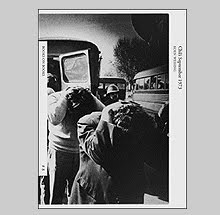
In the late seventies, Groosmont College in El Cajon, California exhibited and published catalogs of three important American photographers in their campus art gallery.
Garry Winogrand exhibited from March 15 to April 2, 1976.
Henry Wessel Jr. exhibited from November 21 to December 17, 1976.
Helen Levitt exhibited from August 25 to September 19, 1980.
The most familiar of the three catalogs is probably the one on the work of Garry Winogrand. What this catalog lacks in its printing quality is made up for in the images. It is a good edit of pictures that later made up a good portion of the Fraenkel Gallery publication A Man in the Crowd (1999). At the time of publication in 1976, Winogrand had only published The Animals and Women Are Beautiful. Ironically, although Women Are Beautiful is primarily made up of images made on the streets, this small catalog was the first substantial publication of the street imagery most talked about when discussing Garry Winogrand.
The second catalog is on the work of Henry Wessel. It is comprised of 40 images reproduced on a matte paper with an introduction by Ben Lifson. The first thing one notices with this catalog is the paper stock it is printed on. The matte texture of the paper was an uncommon choice for the printing of a photography catalog. Although it generally feels cheap and the reproductions are weak, does give a sense of the luminous quality of his work. I think this was the first substantial offering of Wessel's work and the edit includes many of his key images that we have come to know today.
The last catalog is on the color work of Helen Levitt. This little known catalog is my favorite of the three. It is by far, the most elegant and nicely produced since its production was supported by a grant from the National Endowment for the Arts. It starts off with a short essay by Roberta Hellman and Marvin Hoshino and only has 23 plates of her later color street work. The printing of the color is far superior to the recent Powerhouse publication of her color work Slideshow. In Slideshow, the images are muddled and lifeless. Perhaps it was a conscious attempt by the printer to attempt to mimic the quality of the slide film she used but I believe that prints of this work, at the time, were primarily dye transfers which are anything but muddy.
In March of 2000, the Grossmont College and the Hyde Gallery exhibited Henry Wessel's Night Walk work and produced a catalog as well. This last one is made up of 25 images made at night in suburban neighborhoods in California. If you have the slip cased set that was published by Steidl this past year then the small book called Night Walk in that set is practically the same publication. The only difference is the sequence is slightly changed and the reproductions in the Steidl version are much more open and detailed.









































